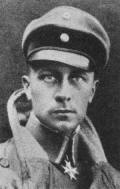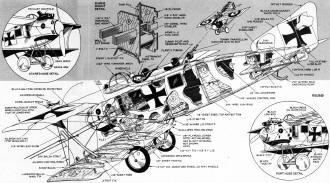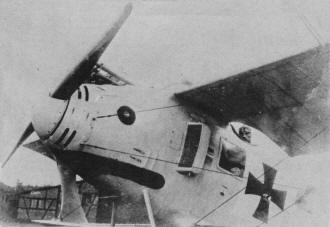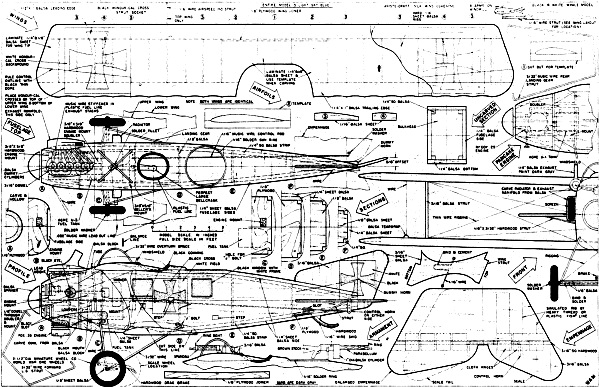|
Douglas Rolfe's sketch of this
Roland C-II biplane is another example of his amazing ability not just to create
a drawing, but to depict the model's construction features in a manner helpful to
builders. That, coupled with the masterfully detailed and laid-out plans by
Walter A. Musciano and a brief history on the airplane along with its most famous pilot, Eduard
von Schleich, makes this an article you won't want to miss - especially if you are
a World War I historian. I have to wonder whether Eduard von Schleich's fellow
Flieger (aviators) referred to him as "verrückte Augen" ("crazy eyes")?
See also
Roland D-2 "Wahlfisch" Control Line Model in the September 1949 Air Trails.
World War-1 Ace von Schleich and His Roland C-II "Wahlfisch"
 Plans for U/Control Plans for U/Control
By Walter Musciano
The Man
Although Eduard von Schleich saw action at the front as a fighter pilot for only
fourteen months during World War One he scored thirty five victories including some
doubles and triples. In addition, this German Ace became the leader of one of four
Jagdgeschwaders ("Flying Circuses") in the German Air Service with rank equal to
von Richthofen. He survived that war to become one of the organizers of the Nazi
Luftwaffe.
A Bavarian, Schleich was born on August 8, 1888 in Bad Tolz, near Munich, Germany.
At the age of twenty he joined the 11th Bavarian Infantry Regiment stationed at
Regensburg; two years later in 1910, Eduard was promoted to Leutnant. When World
War One started he was a company commander. In August 1914 Schleich was seriously
wounded in the shoulder during a battle near Maire, France.
Upon his return to action Eduard decided to transfer to the Air Service; during
1915 he passed the tests for both pilot and observer at the East German Albatros
Works in Schneidemuhl which resulted in his assignment to Bavarian Feldflieger-Abteilung
2b as a pilot. During an observation run Schleich was wounded in the arm by an exploding
anti-aircraft shell. Realizing the importance of the flight, he had his observer
bandage the wound and they continued on course to complete the assignment. Both
men were decorated with the Iron Cross, First Class for this heroic action.

Roland "Wahlfisch" Assembly Sketch
When the future knight recovered from this wound he was given command of Bavarian
Schutzstaffel 28, an escort Staffel. A shortage of aircraft forced the young leader
to sit behind his desk in-stead of leading his men in the air. Schleich was so eager
to fly that when a French Nieuport was forced down on the Schutzstaffel air field
as Commanding Officer he quickly appropriated the craft and had the German crosses
painted over the French insignia. After a few test flights the determined flyer
was ready to go on patrol when the German High Command took the captured plane away.
Schleich complaining bitterly about his inactivity demanded a transfer to a fighter
squadron. Finally, he was sent to a fighter pilot's school where he completed the
course in a record fourteen days.
In March 1917 Eduard Schleich was given command of Jagdstaffel 21 attached to
the German 5th Army. This outfit had one of the poorest combat records, morale was
low. Schleich worked endlessly with his men toward discipline and coordinated action
during aerial combat. In a short time his staffel was the best in the 5th Army.
On May 15, 1917 Schleich was acclaimed for great victory by shooting down a SPAD
piloted by the famous French Ace, Rene Dorme, victor over thirty German planes!
On July 27, 1917 six Albatros scouts from Jasta 21 engaged twenty two SPAD scouts.
In the melee Lt. Erich Limpert plunged to his death. Limpert was Schleich's best
friend. The commanding officer ordered his own Albatros fuselage and tail painted
black. The staffel soon was known as "Dead Man Squadron" to Allied flyers; during
September the men of Jasta 21 accounted for 41 victories; Schleich shot down 17
of these.

Eduard von Schleich in 1940
Although Schleich was a serious, determined pilot and administrator he enjoyed
pranks - unlike many of the other Aces. On one occasion he forced a SPAD to land
on the staffel airfield. During the evening Schleich had black crosses painted over
the French insignia. The following morning the Lieutenant climbed into the French
plane and took off toward the front lines. When the staffel leader sighted a French
SPAD formation he approached them undetected. Several minutes elapsed until the
French leader turned to check his flighy and spotted the strange SPAD with the black
crosses. The startled Frenchman frantically signaled his flight and then all hell
broke loose!
Through skillful maneuvering the German escaped but ran into some trouble as
he crossed over his own lines because the anti-aircraft batteries saw only the silhouette
and not the markings of his plane. A severe reprimand was Schleich's reward after
he landed at his home field.
Just when his staffel was meeting with success the leader was stricken with dysentry.
Before he could return to Jagstaffel 21 Schleich was notified he no longer commanded
the outfit. Jasta 21 was a "Prussian" Staffel and Schleich was a Bavarian. An order
had been issued by the High Command prohibiting anyone but a Prussian to command
a Prussian outfit. Imperial Germany at that time drew a bold line between the state
of Prussia and the other German states, especially Bavaria. The Kaiser and his generals
were Prussians, this was an attempt to keep Prussia in an exalted position. As a
result of this reorganization Jastas 16, 23, 32, 34 and 35 become all-Bavarian Staffels.
Schleich was given command of Jasta 32 attached to the German 7th Army.
On December 4, 1917 Eduard Schleich was presented with the Pour Ie Merite, Germany's
highest decoration. Even his old Jasta 21 sent congratulations. Schleich, not fully
recovered from his illness, was assigned to the military pilots' school at Schleissheim
where he was an extremely valuable instructor due to his expert knowledge of combat
techniques.
When his strength returned Schleich applied for combat duty; in April 1918 he
was given command of Jagdgruppe No.8 comprising Staffels 23, 32 and 35 stationed
at Gavreuil. In June he was promoted to the rank of Hauptmann; the following month
Schleich was awarded the coveted Bavarian Military Order of Max-Josef and an actual
Knighthood. This meant the Ace was known as Hauptmann Eduard Ritter von Schleich.
The "Ritter" being the German equivalent to the English "Sir" when applied to knighthood.
Now Schleich was truly the "Black Knight" and his fame spread along the front.
On Octboer 3, 1918 Ritter von Schleich was placed in command of the new Jagdgeschwader
No.4 which consisted of Jagdstaffel 23 under Lt. Seywald, Jagdstaffel 32, (Schleich),
Jagdstaffel 34 under Oblt. von Greim, and Jagdstaffel 35 under Lt. Stark. This unit
was stationed near Saarburg. Later that month the "Black Knight" was called to Berlin
to test new aircraft at a fighter plane competition; by the time he returned to
his unit the war was over.
During the post-war years von Schleich took an active part in stimulating aviation
interest in Germany. He was employed by Lufthansa airline and was one of the organizers
of the Munich Sport Flyers Club. When Adolf Hitler came to power Ritter von Schleich
became active in the National Socialist movement and helped organize the Hitler
Youth Aviation Program. He joined the newly formed Luftwaffe and was also an officer
in the S.S. in which uniform he visited England and was warmly welcomed. By 1935
von Schleich was a Major in command of a dive-bombing Staffel; during 1938 he was
promoted to Colonel and given command of Jagdgeschwader 132 "Schlageter." This unit
was later renumbered to JG. 26 and became one of the most famous wings on the Western
Front during World War Two.
In 1941, with the rank of General, von Schleich was placed in command of all
Luftwaffe units stationed in Denmark. But he soon retired from this post due to
failing health. He died in 1947.
Acknowledgement
The author thanks A. E. Ferko, N. H. Hauprich, and P. Doyle Jr. for their contribution
of photographs and historical information which helped make this article possible.
The Model

At the front: World War-I Rolands

von Schleich is seen in the cockpit
During November 1915 a new German airplane appeared over the front lines more
advanced than any other. Its wooden monocoque fuselage was carefully streamlined,
wings were filleted, radiators were designed to minimize drag, the usual multiple
interplane struts were replaced with a streamlined "I" strut, cabane struts were
eliminated. This amazing craft was quickly called "der Wahlfisch" ("Whale") because
of its deep, streamlined fuselage. Manufactured by L.F.G. Company (Luftfahrzeug
Gesellschaft), this biplane carried the trade name of Roland - as did other craft
built by L.F.G. Company to avoid confusion with L.V.G. Co., a competitor. The Roland
C-II, designed by Herr Tantzen, set the pattern for many famous designs in later
years.
While Eduard von Schleich was a two-seater pilot with Bavarian Feldflieger Abteilung
2b during the winter of 1915-1916, some of the first Roland C-II's arrived at the
air field. The future Ace was fortunate to have one of the craft assigned to him.
His sense of humor was aroused by the "Wahlfisch" nickname and so he had a mouth
and eyes painted on his plane's nose to heighten the illusion. The Bavarian also
mounted a carved whale on the air speed indicator (as the plans illustrate). Our
model presented is a reproduction of the Roland C-II flown by von Schleich.
The Roland C-II's top speed of 105-mph was faster than the Allies' Nieuport 22
and early Sopwith "Pup" single seaters. English Ace Albert Ball considered the C-II
as the "best German machine now." Yet the craft was under-powered with a 160-hp
Mercedes six cylinder engine - it could have accommodated a more powerful engine
if one had been available.
With a gross weight of 2,825-lbs, 3,280' altitude could be gained in six minutes;
the 13,100' ceiling was reached in 45 minutes. An outstanding performance feature
was its long range. A 5-hour flight time enabled the craft to penetrate deep into
Allied territory on observation duty.
Most early "Wahlfischs" carried only a movable ring-mounted Parabellum machine
gun in the rear cockpit since the C-II could easily outrun single-seater opposition.
This superior speed resulted in some Rolands being used as fighters in which case
a fixed Spandau machine gun was added forward of the pilot's cockpit. While the
deep fuselage afforded a spacious, comfortable cockpit, the wing hindered downward
visibility so windows were fitted in the fuselage side. Due to good streamlining
the craft
landed at fairly high speeds so some early models were equipped with a drag brake
to shorten the roll when landing. The "Wahlfisch" was so successful it remained
in action until the Autumn of 1917.
The plans reveal the Roland makes an ideal control liner. The absence of cabane
struts means solid attachment for both wings; fuselage is rugged and its streamlining
enhances appearance. An engine .23 to .35 cubic inch displacement should provide
ample power, Rib spacing as shown is exact scale.
Construction instructions appear on the full-size Hobby Helpers plans.
Roland C-II List of Material
(Medium balsa unless otherwise noted)
Two 1/4" x 3" x 36" for fuselage sides, top, and bottom, wing tip and center
section; (2) 1/4" x 1/4" x 36" for fuselage interior strips; (2) 1/16" x 3" x 36"
hard for wing ribs; (2) 1/2" x 1" x 36" for wing leading edge; (2) 1/4" x 1" x 36"
for wing trailing edge; (1) 3/16" x 3" x 36" soft balsa for empennage and wing struts;
(1) 1/8" x 2" X 36" for fuselage bulkheads, wing tip and center section; (1) 1/8"
x 6" x 12" plywood for wing joiners and fuselage bulkheads; (1) 3/8" x 5/8" x 18"
hardwood for engine and bellcrank mounts; (1) 1 1/2" x 2" x 18" for nose block cowl
and spinner.
1/16" dia. music wire for control rod and tall skid; 3/32" dia. music wire for
landing gear; white Aristo-craft silk wing covering; 3/16" x 3/16" x 12" hardwood
elevator spar; white and black Wondur-cal Insignia; 8 oz. can Aero Gloss Balsa filler
coat; 4 oz. can Aero Gloss Curtiss Blue Dope; 6 oz. can Aero Gloss Swift White Dope;
(1) tube Aero Gloss Plastic Balsa; one ounce bottle dark gray Aero Gloss dope (optional);
Flex-i-Grit sanding Mylar; (1) large tube Ambroid Cement; (3) 2/0 and 3/0 sandpaper;
8 oz. can Aero Gloss Clear Dope.
Miscellaneous: Straight pins, nuts, bolts, Perfect large bellcrank and control
horn. Acme "U" type tank, plastic fuel line, miniature Wheel Co. 2 1/2" dia. World
War One wheels.
Paint Notes: Mix white and blue dope for the sky blue color.

Roland "Wahlfisch" Control Line Plans
Full size drawings are on Hobby Helpers' Group Plan #962.
Notice:
The AMA Plans Service offers a
full-size version of many of the plans show here at a very reasonable cost. They
will scale the plans any size for you. It is always best to buy printed plans because
my scanner versions often have distortions that can cause parts to fit poorly. Purchasing
plans also help to support the operation of the
Academy of Model Aeronautics - the #1
advocate for model aviation throughout the world. If the AMA no longer has this
plan on file, I will be glad to send you my higher resolution version.
Try my Scale Calculator for
Model Airplane Plans.
Posted December 9, 2021
(updated from original post on 7/18/2015)
|



